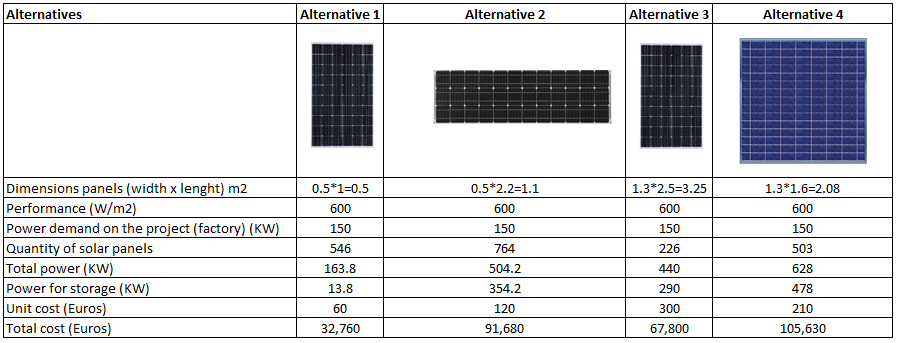In addition to the individual high-performance criteria evaluated in chapter 4.2, the integrated high-performance criteria presented in chapter 3.1 play a fundamental role in the evaluation of the different alternatives. Therefore, the integrated high-performance criteria are now evaluated in order to ultimately be able to make a statement about which of the design variants performs best with regard to both the individual and the integrated high-performance criteria.
In the following table, each of the integrated high-performance criteria is evaluated step by step. For this purpose, the previous high-performance criteria will be considered. Here the goal is to keep the costs of the project low while not compromising quality. In order to be able to evaluate this criterion better, the following table is considered:

The table shows a compilation and cost estimate for the main materials of the integrated system for the four alternatives. Here, the volume and the main materials are considered. When looking at the combined costs, Alternative 1 stands out in particular as it digresses significantly in the cost comparison. While the costs considered for Alternatives 2, 3 and 4 range from 3,083,841 to 3,859,586 Euros, the cost for Alternative 1 is just 1,382,210 Euros. At first glance, therefore, the ideal alternative seems to have been found for the customer, since this alternative is by far the cheapest. However, this must be examined more closely in the further course, since such a cost discrepancy can often also be deceptive.
When looking at the following diagram, it is noticeable that especially the volume costs vary strongly between the alternatives. This is due to the fact that the parameters length, width and height vary. The findings already made in chapter 4.2 are also legitimized here. For example, it can be seen that Design Alternative 1 has the lowest costs. However, it is important to note that the cost saving has a negative impact on the efficiency (since here the area and volume are minimal in comparison) and thus lowers the quality, which is not the goal. It is clear that Design Alternatives 2 and 3 perform the best, as they are both superior when considering the individual high-performance criteria (see 4.2). In terms of cost, Design Alternative 3 is the optimal solution, as this option has the lowest cost compared to Alternatives 2 and 4.

After the costs have been considered in more detail, the second high-performance criteria will be evaluated in the next step. This involves maximizing the power output of the photovoltaic system. Each of the different variants has panels with the same performance (600 W/m2). However, depending on the design alternative, the number of rows and dimensions of the panels differ. This leads to differences in the total power output of each alternative. The following table shows the key figures for the four different design alternatives:

Finally, it will be evaluated whether the third integrated high-performance criterion has been achieved in this project. Here, the goal is to fulfill the individual high-performance criteria in the integrated civil system as best as possible. Chapter 4.2 has already evaluated which of the design variants performs best with regard to all individual high-performance criteria.
In conclusion, it can be said that Design Alternative 3 is the most suitable for the customer. In the comparison of the individual high-performance criteria, it is only slightly below Alternative 4, which performs best in this analysis, and thus offers a balanced and effective solution. In terms of cost, this alternative performs the best at 3,083,841 Euros, since here the quality is not significantly negatively affected, as is the case in alternative 1. With regard to the maximum power output, alternative 3 does not perform best, but meets the power demand of 150 kW/h. Therefore, it is recommended to the customer not to maximize it, since Alternative 3 already guarantees an optimal energy supply and 290 kW/h of generated energy can be stored, which corresponds to 2 months of demand. However, it is also noted that this alternative takes up the most space.